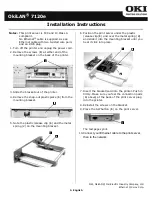
78
SyncServer 600 Series User’s Guide
098-00720-000 Revision B – April, 2016
Chapter 4
Navigation Windows
Leap Indicator
The Leap Indicator (LI) is a two-bit binary number in the NTP packet header that
provides the following information:
Advance warning that a leap second adjustment will be made to the UTC
timescale at the end of the current day. Leap seconds are events mandated
by the world time authority (BIPM) in order to synchronize the UTC time scale
with the earth's rotation.
Whether the NTP daemon is synchronized to a timing reference.
LI
Meaning
00
No
Warning
01
Leap second insertion: Last minute of the day has 61 seconds.
10
Leap second deletion: Last minute of the day has 59 seconds.
11
Alarm condition (Not synchronized)
When the SyncServer or NTP daemon is started or restarted, the leap indicator is
set to "11", the alarm condition. This alarm condition makes it possible for NTP
clients to recognize that an NTP server (the SyncServer) is present, but that it
has yet to validate its time from its time sources. Once the SyncServer finds a
valid source of time and sets its clock, it sets the leap indicator to an appropriate
value. The NTP Leap Change Alarm on the ADMIN - Alarms page can be
configured to generate an alarm and send notifications each time the leap
indicator changes state.
Stratum
This is an eight-bit integer that indicates the position of an NTP node within an
NTP timing hierarchy. It is calculated by adding 1 to the stratum of the NTP
system peer. For the SyncServer, the stratum values are defined as follows:
Stratum
Meaning
0
Hardware
Clock when locked
1
Primary server
2-15
Secondary
server
16-255
Unsynchronized, unreachable
For example, the SyncServer is:
stratum 1 when the Hardware Clock (stratum 0) is synchronized to an input
reference, in holdover mode, or in freerun mode.
stratum 2 through 15 when it is synchronized to a remote NTP server.
stratum 16 when it is unsynchronized, indicating that it is searching for a valid
source of timing information.
Log2 Precision
This is a signed integer indicating the precision of the selected peer clock, in
seconds to the nearest power of two. A typical value is -18 for a Hardware Clock
where the uppermost 18 bits of the time stamp fractional component have value,
indicating a precision in the microsecond range.
Table 4-4. NTPd SysInfo Parameter Descriptions (Continued)
Parameter
Description
















































